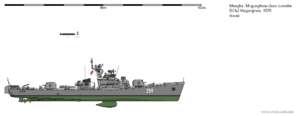Mugunghwa-class corvette
 3-view image of Mugunghwa in her as-built layout.
| |
| Class overview | |
|---|---|
| Name: | Mugunghwa class |
| Builders: |
|
| Operators: | Menghe |
| Preceded by: | Jangmi-class corvette |
| Built: | 1971-1984 |
| In service: | 1975-2009 |
| Completed: | 32 |
| Lost: | 1 |
| General characteristics Mugunghwa-class, as built | |
| Type: | Anti-submarine corvette |
| Displacement: |
|
| Length: |
|
| Beam: | 10.6 m |
| Draft: | 3.7 m (to keel) |
| Propulsion: |
|
| Speed: | 31 knots |
| Range: | 2,200 nautical miles (4,000 km) at 12 knots |
| Complement: |
|
| Armament: | |
The Mugunghwa-class corvettes were a group of 32 warships built in the Democratic People's Republic of Menghe during the 1970s and 1980s. They were initially classified as Medium Anti-Submarine Patrol Ships, and later reclassed as Small Anti-Submarine Patrol Ships. While inexpensive to build, they suffered from poor oceangoing seaworthiness and weak sensors. The last ships in the class were decommissioned in the 2000s.
Development
The Mugunghwa-class corvettes were developed during the late 1960s as a replacement for the Jangmi-class corvettes, themselves license-built versions of the Letnian Petya-class frigate. In terms of their capabilities, the two classes were similar; the main aim of the program was likely to strengthen Menghe's domestic shipbuilding industry.
Characteristics (as built)
Despite their different hull form, the Mugunghwa-class corvettes were similar in their internal layout to the Jangmi-class corvettes they succeeded. The powerplant was copied from the Letnian type, with two M-2 15,000 hp gas turbines for sprint operations and one diesel engine for cruising. Each engine was hooked up to a single propeller shaft; on gas turbine power, the diesel engine's centerline shaft would trail in the water with the propellers feathered, and vice versa while cruising. The powerplant was relatively noisy in both modes, interfering in passive sonar detection and making it easy for submarines to avoid the ship.
The main anti-submarine armament of the Mugunghwa-class corvettes was a quintuple torpedo tube launcher mounted aft of the funnel. This was capable of launching wire-guided homing torpedoes. Forward of the bridge, the ships also carried two RBU-6000 depth charge rocket launchers, which could reload automatically from a magazine below decks. On the quarterdeck, the ships could mount depth charge racks over the ends of their mine rails, an anachronistic feature even for the 1970s. Anti-submarine sensors consisted of a hull-mounted MG-312 "Titan" sonar and a dipping sonar on the quarterdeck; the latter could only be deployed while stationary.
Self-defense armament consisted of two AK-762 twin 76mm turrets and one manually-aimed surface-to-air missile launcher. On early-production hulls this carried four YDG-31 missile tubes; it was later modified to carry YDG-34 missile tubes. Both are heat-seeking man-portable air-defense systems, and do not rely on radar for guidance. Eight to twelve reloads are carried.
Refits and modifications
Juksun, the 26th ship in the class, was completed in December 1981 as a trials ship for the YDG-36 anti-ship missile. In place of her aft turret, she carried an eight-box traversing launcher and missile magazine, as well as a guidance radar. The dipping sonar was retained, and following trials Juksun has been seen on regular patrols, suggesting that the ship is still fully operational despite her unusual modified layout.
Yusu, the 4th ship in the class, was modified in 1990 to carry a towed array sonar of unknown origin, likely either domestic or copied from a foreign source. This required the deletion of the aft turret. The sonar handling equipment was left mostly exposed, suggesting that Yusu was testing a sonar system for a future corvette class rather than a prospective Mugunghwa upgrade.
The actual Mugunghwa upgrade first appeared in 1996, and used a variable-depth sonar of Menghean design. Unlike the old dipping sonar, this could be deployed while moving, and it was reportedly more sensitive in the active and passive modes. The sonar, sonar handling equipment, and sonar control room were placed in a large deckhouse aft, which covered the entire quarterdeck and required the removal of the aft turret. The air and surface search radar was also replaced with a newer type, and the torpedo tubes were modified to support the HŎ-2 Poksŏl.
In 2002, Juksun was seen with a Subisu CIWS mount in place of the YDG-36 launcher. This may have been meant to test the ability of the Subisu to fit in the missile magazine of the YDG-36 system, or to test the Subisu's suitability for small combatants. The Subisu system was functional in this configuration, and was even tested against target drones, but the ship apparently suffered from serious weight distribution issues. She did not embark on any patrols in this configuration, and she was decommissioned in 2005.
Role
The Mugunghwa-class corvettes were originally intended as green-water combatants, able to patrol areas within 500 kilometers of Menghe's coast. For this role, they had moderate autonomy given their size, and no onboard helicopter facilities, as they would rely on shore-based patrol aircraft. They did, however, carry variable-depth dipping sonar to detect targets below the thermocline.
Due to their small displacement, low freeboard aft, and structurally weak stepped-deck design, they proved to be poor seaboats on the open ocean, especially in stormy weather. One ship in the class, Rŭngsohwa, capsized in a typhoon in 1996, killing all on board. After this incident, Mugunghwa-class ships were mostly relegated to coastal patrol duties, and plans to decommission them were accelerated.